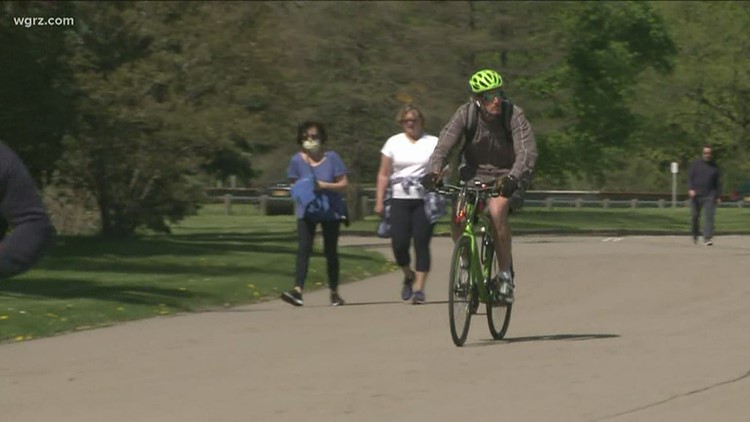BUFFALO, N.Y. — May is National Bike Safety Month, and The New York State Division of Consumer Protection and the New York State Governor's Traffic Safety Committee is reminding people to wear their helmets.
As the weather gets nicer, more people are taking to the trails and roads by bike. They should keep safety in mind.
“Helmets are vital safety gear that saves lives when we are exercising and enjoying a bike ride with family and friends,” New York Secretary of State Robert Rodriguez said. “As the summertime is upon us and we enjoy the warm weather biking in New York’s many beautiful bike trails, parks, and on the streets, I urge all New Yorkers to be smart while having adventures on two-wheels by wearing a helmet and proper gear while riding a bike.”
The Institute for Traffic Safety Management and Research (ITSMR), in 2021 there were 3,946 police-reported bike crashes where a helmet was not used. Of those crashes, 32 resulted in at least one fatality, compared to 1,455 reported accidents where a helmet was used that resulted in seven crashes with at least one fatality.
Additionally, ITSMR data showed that of the accidents where a helmet wasn't used last year 378 resulted in at least one serious injury and of the accidents involving people with helmets 121 resulted in at least one serious injury.
“The statistics clearly show that wearing a helmet while bicycling significantly reduces the chances of death or serious injury in the event of a crash,” said GTSC Chair and NYS DMV Commissioner Mark Schroeder. “Please wear a helmet every time you ride a bicycle. It could save your life.”
DCP provided the following tips for how people can properly wear their helmets:
- Pair the activity to the helmet. You shouldn’t wear any helmets to go bike riding. Different activities can result in different impacts to your head. Use a helmet that fits the activity, so if an accident occurs, you are better protected.
- Read the directions. With helmets, it’s important to follow the manufacturer’s instructions. Every helmet can fit and operate differently.
- Make sure it fits. Bike helmets should have a snug but comfortable fit on the rider's head. The National Highway Traffic Safety Administration (NHTSA) also has a guide on properly fitting bicycle helmets, helmet certifications and laws, and more.
- Buckle up! A helmet only works when it is worn properly for the duration of an activity. Make sure your helmet has a chin strap and buckle that lays flat and stays fastened. Wear your helmet level on your forehead, not tilted back.
- Conform to regulations. The CPSC oversees helmets for many activities, including bike riding. For instance, bicycle helmets must conform to five separate standards[1]. When buying a bike helmet, look for the label that reads: “Complies with U.S. CPSC Safety Standards for Bicycle Helmet.” Don’t add anything to the helmet, such as stickers, coverings, or other attachments, that didn’t come with the helmet upon purchase. These could affect the helmet’s performance.
- After a crash or injury, replace. Once a helmet protects a person from a fall, it should no longer be used. Any damage to a helmet can reduce its effectiveness. Replace it before the next ride.
- Replace your helmet when needed. You should follow the manufacturer’s guide for when to replace your helmet. If no guidance is provided, helmets should generally be replaced within 5-10 years of purchase if properly cared for and stored. If there are cracks in the shell, worn foam lining, or other such imperfections that may occur during regular use, you should consider replacing them.
More information is available from CPSC.



